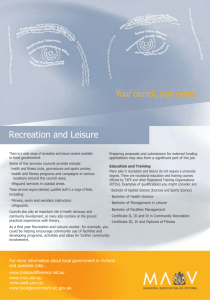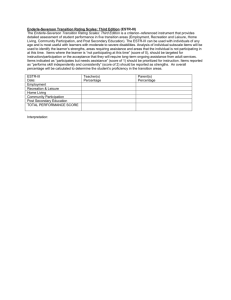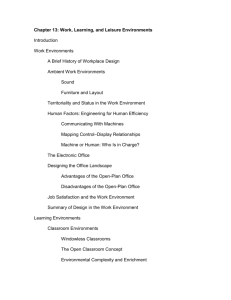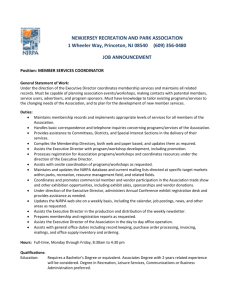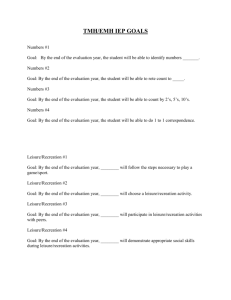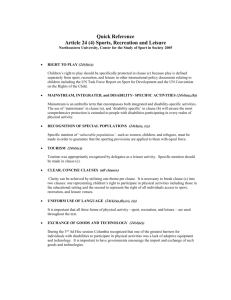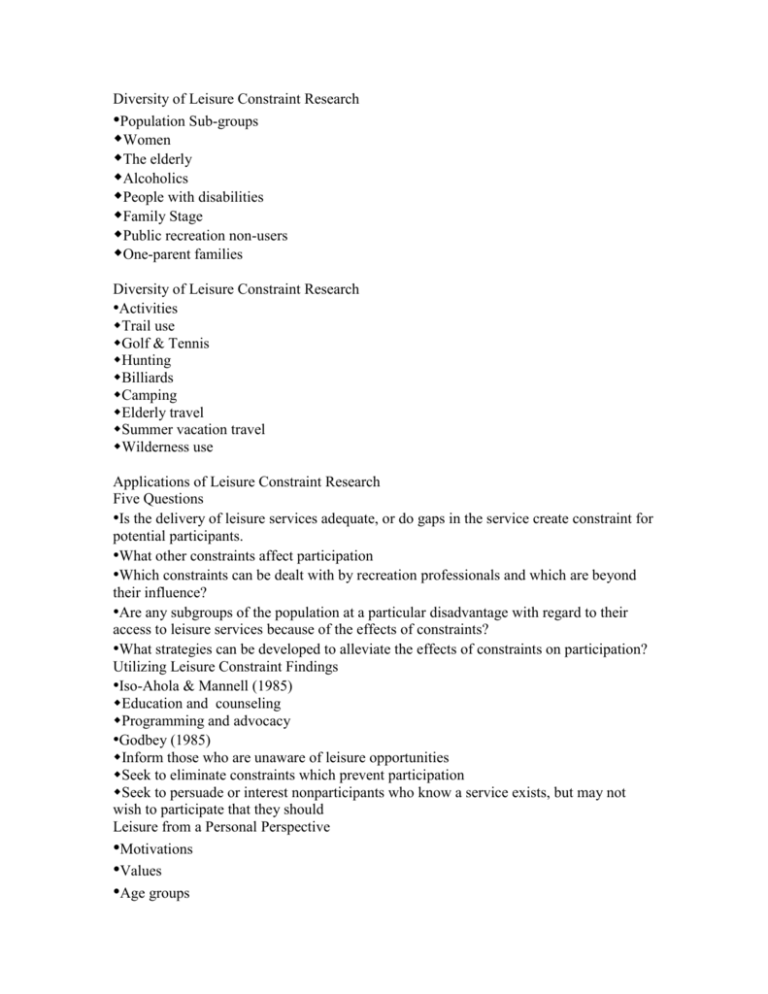
Diversity of Leisure Constraint Research
•Population Sub-groups
Women
The elderly
Alcoholics
People with disabilities
Family Stage
Public recreation non-users
One-parent families
Diversity of Leisure Constraint Research
•Activities
Trail use
Golf & Tennis
Hunting
Billiards
Camping
Elderly travel
Summer vacation travel
Wilderness use
Applications of Leisure Constraint Research
Five Questions
•Is the delivery of leisure services adequate, or do gaps in the service create constraint for
potential participants.
•What other constraints affect participation
•Which constraints can be dealt with by recreation professionals and which are beyond
their influence?
•Are any subgroups of the population at a particular disadvantage with regard to their
access to leisure services because of the effects of constraints?
•What strategies can be developed to alleviate the effects of constraints on participation?
Utilizing Leisure Constraint Findings
•Iso-Ahola & Mannell (1985)
Education and counseling
Programming and advocacy
•Godbey (1985)
Inform those who are unaware of leisure opportunities
Seek to eliminate constraints which prevent participation
Seek to persuade or interest nonparticipants who know a service exists, but may not
wish to participate that they should
Leisure from a Personal Perspective
•Motivations
•Values
•Age groups
Personal Influences
•Have fun
•Improve skills
•Stay in shape
•Something I’m good at
•Excitement
•Social and Affiliation Drives
•Excitement and Challenge motivations
•Hedonistic
Personal Values
•Physical Values
•Control Obesity
•Cardiovascular health
Emotional Values
•Relaxation/escape
•Overcome loneliness
•Stress management
Emotional Release
•Self-Actualization (YUCK!!)
•Balance between work and play
Social Values
•Sport as social development
•Play as social mobility
•Play as way of learning
Holistic Wellness
•Wellness concept of health
•Emotional Intelligence
Improving consideration for others
Developing ability to work together
Improved social skills
Developing feelings of success
Improved decision making
Age groupings
•Children
Play
•Solitary
•Parallel
•Associative
•Cooperative
•Adult
•Elderly
Influence on Child’s play
•Decline of Family structure
More divorce
Single family
•No Room for play
•Influence of Commercial Media
Adolescents
•Subcultures
“fun” subculture
“academic” subculture
“delinquent” subculture
•Drinking & sexual behavior
•Mass Media
•Fast-Forward generation
Adulthood
•Singles
•College age
•Married
•Middle adult years
•Stability
Elderly
•Ulesseian Adult
•Senior Centers
•Elderhostels
Leisure from a Personal Perspective
•Motivations
•Values
Personal Values
Societies values
•Age groups
Motivation (types)
•Physical Perspective
•Social
•Psychological
•Emotional, intellectual, spiritual
Physical Motives
•Physical Values
Being active
•Control Obesity
Weight Management
•Cardiovascular health
•Wellness Concept of Health
Holistic perspective
Personal Influences
•Have fun
•Improve skills
•Stay in shape
•Something I’m good at
•Excitement
Social Motivators
•Social and Affiliation Drives
Only 2% of leisure activities are done alone
•We need to feel like we belong in a group
As many as ¾ of college students indicate they experienced loneliness their first
semester in college
•Group type activities
YMCA, CPA, Intramurals, BSU, MSU etc.
Psychological Motivators
•Excitement and Challenge motivations
•Relaxation and Escape
•Stress Management
Get my head screwed on straight
•Healthy Balance of Work and Play
Spillover & Compensation
•Hedonistic
Maximizing pleasure minimizing pain
Sensual in nature (dealing with the senses)
Emotional Values
•Maslow’s Hierarchy of Needs
Physiological need
Safety need
Social need
Ego Need
Self-actualization
•Overcome loneliness
•Intellectual values and outcomes
Assimilation and accommodation
Spiritual Values
•Spirituality
“a capacity for exhibiting humanity’s higher nature-a sense of moral vales, compassion,
and respect for other humans and for the earth itself.”
A search for higher meaning
Social Values
•Sport as social development
•Play as social mobility
•Play as way of learning
Holistic Wellness
•Wellness concept of health
•Emotional Intelligence
Improving consideration for others
Developing ability to work together
Improved social skills
Developing feelings of success
Improved decision making
Age groupings
•Children
Play
•Solitary
•Parallel
•Associative
•Cooperative
•Adult
•Elderly
Influence on Child’s play
•Decline of Family structure
More divorce
Single family
•No Room for play
•Influence of Commercial Media
Adolescents
•Subcultures
“fun” subculture
“academic” subculture
“delinquent” subculture
•Drinking & sexual behavior
•Mass Media
•Fast-Forward generation
Adulthood
•Singles
•College age
•Married
•Middle adult years
•Stability
Elderly
•Ulesseian Adult
•Senior Centers
•Elderhostels
Age groupings
•Children
Play
•Solitary
•Parallel
•Associative
•Cooperative
•Adult
•Elderly
Influence on Child’s play
•Decline of Family structure
More divorce
Single family
•No Room for play
•Influence of Commercial Media
Adolescents
•Subcultures
“fun” subculture
“academic” subculture
“delinquent” subculture
•Drinking & sexual behavior
•Mass Media
•Fast-Forward generation
Adulthood
•Singles
•College age
•Married
•Middle adult years
•Stability
Elderly
•Ulesseian Adult
•Senior Centers
•Elderhostels
Sociocultural Influences on Leisure
•Gender vs. sex
•Sexual orientation
•Race & Ethnicity
Gender vs. Sex
•Gender
Broad range of characteristics used do describe roles attached to males and females
•Sex
Biological or physical classifications of human sexuality
Women’s Leisure
•Male dominated society
•Impacts of the feminist movement
•Title IX
•Leisure opportunities
•Leisure constraints
Intrapersonal
Interpersonal
Structural
Men’s Leisure
•Shifting masculine identities
Sexual Orientation’s affect on Leisure
•Openness of “Alternative Lifestyles”
•Lesbian, Gay, Bisexual or Transgendered
Race and Ethnicity
•Race
Genetic makeup of a person
•Ethnicity
Unique social and cultural heritage that is passed from one generation to the next.
•Labels
•Segregation & exclusion
•Self-segregation
Race and Ethnicity
•1997 study
Significant group of teenagers have “moved beyond their parents’ view of race”
Race and Ethnicity
•Race
Genetic makeup of a person
•Ethnicity
Unique social and cultural heritage that is passed from one generation to the next.
•Labels
•Segregation & exclusion
•Self-segregation
Race and Ethnicity
•1997 study
Significant group of teenagers have “moved beyond their parents’ view of race”
Adolescents
•Subcultures
“fun” subculture
“academic” subculture
“delinquent” subculture
•Drinking & sexual behavior
•Mass Media
Glamorization of sex and violence
Life Goes On
•Fast-Forward generation
Leisure Boredom
Adolescents
•Age 10-14
Least understood and “most neglected phase of life span form conception to
senescence”
Time spent with parents has decreased by 1/3 over the past 30 years.
Adulthood
•Singles
•College age
Approximately 2 in 5 students drinks excessively
•Married
Late 30’s
Beginning to make mark in the world (children, career)
•Middle adult years
•Stability
Chapter 7
•Benefits of recreation
Benefits based model
•Target issues
•Activity components
•Benefits outcomes
•Benefits based awareness
Chapter 7
•Community benefits
Community: significant clustering of people who have a common bond i.e.
neighborhood, city etc.
•NRPA benefit categories
Personal, social, economic, environmental
Functions of Park and Recreation Agencies
•Function 1: Enriching the quality of life
Purpose: to enrich the quality of life in the community setting by providing pleasurable
and constructive leisure opportunities for residents of all ages, backgrounds and
socioeconomic classes
Functions of Park and Recreation Agencies
•Function 2: Contributing to personal development
Purpose: To contribute to a person’s healthy physical, social, emotional, intellectual,
and spiritual development, as well as to family cohesion and well being.
Functions of Park and Recreation Agencies
•Function 3: Making The community a more attractive place to live
Purpose: To improve the physical environment and make the community a more
attractive place to live by providing a network of parks and open spaces, incorporating
leisure attractions in the redesign and rehabilitation of run-down urban areas, and
fostering positive environmental attitudes and policies.
Functions of Park and Recreation Agencies
•Function 4: Preventing antisocial uses of free time
Purpose: To prevent or reduce antisocial or destructive uses of free time, such as
delinquency or substance abuse, by providing challenging programs that offer young
people constructive and enjoyable recreation opportunities linked to other needed
services.
Functions of Park and Recreation Agencies
•Function 5: Improving inter-group and intergenerational relations
Purpose: To help improve intergroup relations among community residents of different
racial, ethnic, or religious backgrounds, and among different generational groups, through
shared recreational and cultural experiences.
Functions of Park and Recreation Agencies
•Function 6: Strengthening neighborhood and community ties.
Purpose: To strengthening neighborhood and community life by involving residents in
volunteer projects or service programs and events to enhance civic pride and morale.
Functions of Park and Recreation Agencies
•Function 7: Meeting the needs of special populations.
Purpose: To serve special populations such as those with physical or mental disabilities,
both through therapeutic recreation service in treatment settings and through communitybased programs serving individuals with a broad range of disabilities.
Functions of Park and Recreation Agencies
•Function 8: Maintaining economic health and community stability.
Purpose: To maintain the economic health and stability of communities by acting as a
catalyst for business development and a source of community or regional income and
employment and by keeping neighborhoods desirable places to live.
Functions of Park and Recreation Agencies
•Function 9: Enriching community cultural life.
Purpose: To enrich cultural life by promoting fine and performing arts, special events,
and cultural programs and by supporting historic sites, folk heritage, customs, and
community arts institutions.
Functions of Park and Recreation Agencies
•Function 10: Promoting health and safety.
Purpose: To promote community health and safety by offering needed services and
programs, including leadership training and certification courses and supervision of highrisk activities.
Functions of Park and Recreation Agencies
•Function 1: Enriching the quality of life
•Function 2: Contributing to personal development
•Function 3: Making The community a more attractive place to live
http://www.greenvillesouth.com/rivPark1.html
•Function 4: Preventing antisocial uses of free time
•Function 5: Improving inter-group and intergenerational relations
•Function 6: Strengthening neighborhood and community ties.
•Function 7: Meeting the needs of special populations.
•Function 8: Maintaining economic health and community stability.
•Function 9: Enriching community cultural life.
•Function 10: Promoting health and safety.
Functions of Park and Recreation Agencies
•So, what does a park and recreation agency do?
??????
•Should Park and recreation agencies do it?
•Should we take money from education to support park and recreation agencies?
Leisure Service Delivery System
•An organized delivery system for the provision of leisure services to the, town
community, or region.
Types of leisure service agencies
Governmental
Nonprofit
Commercial
Employee service and recreation programs
Armed forces recreation (Morale, Welfare and Recreation)
Private Membership Clubs
Campus Recreation
Therapeutic Recreation Services
Sports Management Organization
Tourism and hospitality industry
Government Service Providers
•Characteristics
•They were the first type of agency to be formally recognized as responsible for
providing recreation services for the public
•Primarily supported through taxes
•Responsible for management of natural resources
•Obligated to serve the public at large
Government Service Providers
•Direct Management of recreation resources
•Conservation and resource reclamation
•Assistance to open space and park development programs
•1965 Land and Water Fund Conservation Act
•Direct programs for recreation participation
•Veteran Affairs
•Advisory and financial assistance
•Department of Health and Human services, HUD
Government Service Providers
•Aid to professional education
•Promotion of recreation as an economic function
•Research and technical assistance
•Regulation and Standards
Government Service Providers
•National Park Service (NPS)
•United States Forest Service (USFS)
•Bureau of Reclamation
•Bureau of Land Management (BLM)
•U.S. Fish and Wildlife Service
•U.S. Corps of Engineers
•Tennessee Valley Authority
Government Service Providers
•National Park Service (NPS)
•Department of the Interior
•Leading federal agency providing outdoor recreation
•79 million acres
•Approximately 280 million visitors in 2001
•Overcrowding & other issues
•Lead to the following initiatives
•Higher fees
•Stricter policies concerning off-road use
•Remodeling of parking areas & roads in major areas to reduce traffic
•Stronger emphasis on interpretation and minority and women issues
Government Service Providers
•United States Forest Service (USFS)
•Department of Agriculture
•Large areas of grassland & forest stands
•Main purpose was not recreation but utilization
•192.4 million acres
•35 million acres of Wilderness
•214 million visitors
•NRUM survey
Government Service Providers
•Bureau of Reclamation
•Responsible for water resource development
•Originally intended to promote irrigation and electric power
•Since 1936 has accepted recreation as a responsibility
•Transfers areas where possible (National Recreation Areas NPS)
•Emphasis is on active recreation not just sightseeing
•Bureau of Land Management (BLM)
Government Service Providers
•Bureau of Land Management (BLM)
•Largest federal land manager
•260 million acres
•Often called the Bureau of Livestock and Mining
•Multipurpose use of land
•U.S. Fish and Wildlife Service
•Originally two federal bureaus
•Primary purpose is the protection of habitat for fish wildlife services
•Recreation is also provided, but it is not the primary purpose
Government Service Providers
•U.S. Corps of Engineers
•Responsible for improvement and maintenance of rivers & other waterways
•11 million acres of federally owned land and water impoundments
•460 reservoirs & lakes
•Largest provider of water based recreation in America.
•Tennessee Valley Authority
•Pseudo-governmental agency
•Water based recreation important
•Often in the news for negative reasons
•Works with other agencies to provide recreation opportunities although that is not their
primary purpose.
Government Service Providers
•Bureau of Indian Affairs
•Provides Native Americans health, education, economic development and land
management
•Department of the Interior
•56 million acres owned by Native Americans
•More than 5,500 lakes
•Camping, hunting fishing etc.
Government Service Providers
•Health and Human Services
•Public health
•HUD
•Community Development grants
•Arts & Humanities Support
•National Endowment for the Arts (NEA)
•1980’s over 180 million dollars for the arts
•Physical Fitness
•1956 President’s Council on Physical Fitness
State Government
•“The powers not delegated to the United States by the Constitution, or prohibited by it
to the States, are reserved to the Stated respectively, or to the people.”
•This enables Stated to provide recreation and other welfare services.
Outdoor recreation and States
•State parks areas:
•State recreation sites
•State natural areas
•State historic sites
•State environmental education sites
•State scientific areas
•State trails
Outdoor recreation and States
•Large increase in state park holdings during the 1960’s and 1970’s with the help of the
Land and Water conservation fund
Other State Functions
•Just as the federal government assists states with recreation, states assist local
governments with recreation
•State fairs
•Therapeutic recreation services
•Green Valley
•Promotion and professional advancement
•You are in it!
•Development and enforcement of standards
County and Local Governments
•The local government is the closest to the people and therefore most able to meet the
widest range of recreational needs.
•County and special park districts
•Special areas set up with the intention of providing and integrated service approach
•Regional and special park districts
Municipal Recreation and Park Departments
•Municipal government: the local political unit of government
•Functions of municipal agencies
•Police department
•Welfare department
•Youth boards
•Health and hospital agencies
•Public housing departments
•Cultural departments
•School systems and local community colleges
Municipal Recreation and Park Departments
•What do they do?
•A better question would be what don’t they do?
•Fitness programming
Fee based programs
•With the fiscal cutbacks in the 1980’s and the “reinventing government” many agencies
don’t have the funding they once had
•To fee or not to fee? That is the question!!!
Nonprofit Organizations
•Nonprofit/voluntary organizations
•They can (and often do) charge a fee
•Nonprofit youth-serving agencies
•Nonsectarian youth-serving organizations
•Religiously affiliated
•Special interest
•Conservation and outdoor recreation
•Youth sports and games
•Arts councils
•Service and federal clubs
Nonprofit Organizations
•Nonsectarian youth-serving organizations
•Boy Scouts of America
•Girl Scouts of the U.S.A.
•Boys & Girls Clubs of America
•Police Athletic Leagues (PAL)
•Camp Fire USA
Nonprofit Organizations
•Religiously affiliates youth-serving organizations
•YMCA and YWCA
•Catholic youth organization
And now for something completely different
•Travel and tourism
•What is travel?
Movement from one location to another.
•What is tourism?
Tourism
•Activities of persons traveling to and staying in places outside their usual environment
for not more than one consecutive year for leisure, business or other purposes.
Usually further than 50 miles
Other Tourism Definitions
•Demand Side
“… the action and activities of people taking trips to a place or places outside of their
home communities for any purpose except daily commuting to and from work.”
Other Tourism Definitions
•Supply Side
“… the aggregate of all businesses that directly provide goods or services to facilitate
business, pleasure, and leisure activities away from the home environment.”
Other Tourism Definitions
•Holistic Side
“Tourism is the study of man away from his usual habitat, of the industry which
responds to his needs, and of the impacts that both he and the industry have on the host’s
socio-cultural, economic, and physical environments.”
Tourism Factoids
•The U.S. generates more tourism revenues than any other country in the world
•Close to 7% of the GDP of the U.S. is tourism generated
•Travel and tourism is the second largest employer in the U.S.
•Tourism generates more revenue worldwide than the automobile industry
Tourism Factoids (cont)
•Between 65% and 75% of all leisure travel is accounted for by the family vacation
market
•64 million Americans take camping vacations annually
•Car travel accounts for 80% of all summer vacation travel
•International tourists spent 439 billion U.S. Dollars in 1998
Values of Tourism
•Enriching personal life quality through the provision of life transforming experiences
•Building community life quality and promoting peace and harmony among people
•Breathing new life into rural and urban economies
•Weaving greater environmental and social equity consciousness
Gunn’s Top 8 Tourism Fallacies
•Fallacy: Tourism is and industry
•Fact: Tourism does not meet the orthodox definition of “industry.”
•Fallacy: Hotels and airlines drive the tourism industry
•Fact: Hotels and airlines are facilitators, not causes
Gunn’s Top 8 Tourism Fallacies
•Fallacy: Tourism can be developed anywhere
•Fact: Some areas have greater potential
•Fallacy: Billboards and advertising can create tourism
•Fact: Only an improved product can create tourism
Gunn’s Top 8 Tourism Fallacies
•Fallacy: Tourism has no costs
•Fact: Tourism has several costs
•Fallacy: Tourism and environmentalism are incompatible
•Fact: Tourism can not exist without environmental protection
Gunn’s Top 8 Tourism Fallacies
•Fallacy: Rural areas and small towns should “go it alone.”
•Fact: Rural areas and small towns have much to gain by cooperating with nearby larger
cities.
•Fallacy: Chambers of commerce provide the best tourism leadership
•Fact: New organizational structures serve tourism better.



